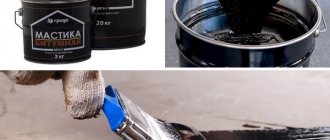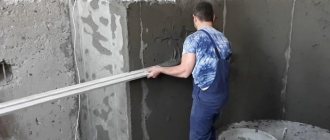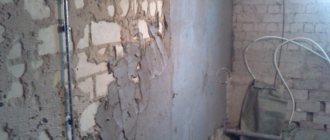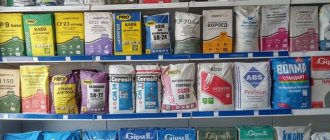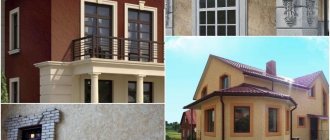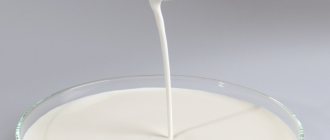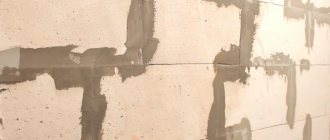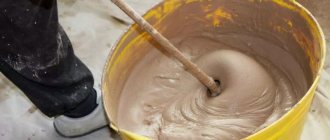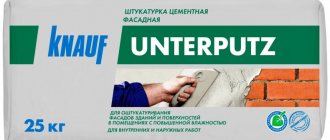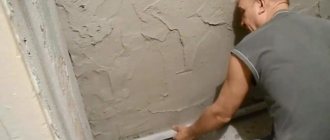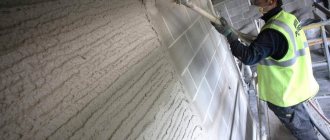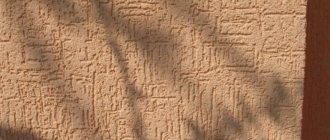Home / Installation, repair, maintenance / Finishing / Elastic putty - what is it and where is it used?
This composition was specially developed for repairing cracks and other defects in moving and deforming foundations. Elastic putty, unlike plastering compounds with the same properties, is mostly not used to create a beautiful surface on the outside of a building. Much better, it is suitable for interior decoration.
What is elastic putty
Elastic putty is understood as a putty solution based on synthetic polymers, which has high ductility, resistance to damage and cracking due to its ability to stretch. This material can bend, repeating the shape of the base, fully performing its functions and without deteriorating under the influence of surface tension.
The use of elastic compounds opens up new possibilities for finishing and protecting various materials and substrates. The mixtures hide defects or completely eliminate them, seal seams, and also protect problem areas from mechanical damage and weather conditions. Even dissimilar surfaces can be covered with a continuous layer of such putty - cracks will not appear after many years.
It is especially recommended to apply products with high elasticity in fragile areas, as well as for additional protection of monolithic structures. Otherwise, elastic compounds have all the properties of conventional putties, while being easy to level and have a long service life.
Putty "Extra" for wood
Fine-dispersed putty for sealing knots, cracks, other wooden surfaces and carrying out other important work.
- can be used as a finishing putty, incl. in places with high humidity or in periodic contact with water;
- recommended for sealing knots, cracks and other defects in carpentry;
- high moisture resistance, hardness and strength;
- imitates the color of untreated wood.
Application area
For sealing knots, cracks and other defects of wooden surfaces, as well as for carrying out other important finishing works on fiberboard, MDF, chipboard, concrete, brick, plaster, etc.
Compound
Aqueous polymer dispersion, pigment, filler, modifying additives.
Basic colors
| Tensile strength with uniform tearing, kg/cm²: | Not less than 5 kg/cm². |
| Properties and features: | Low-shrink putty, does not chalk after drying, gives a durable, smooth matte surface. Provides high water resistance, hardness and durability of the coating. The putty contains fine filler, so it can be used as a finishing putty. Available in several colors: “white”, “birch”, “pine”, “oak”, “beech”, “mahogany”, “larch”, “wenge”, “light gray oak”. |
| Surface preparation: | The working surface must be dry and free of dirt. Peeling old coatings must be removed. |
| Consumption: | 0.5-1.4 kg/m² |
| Application method: | The putty is applied with a spatula in a continuous layer. The optimal thickness of the applied putty layer is about 1 mm. It is allowed to seal irregularities up to 7 mm deep. For large uneven areas, multi-layer application of putty is recommended. Sanding should be done 3-5 hours after application. |
| Drying time: | Touch-free in 2 hours, completely dry after 24 hours under normal conditions (with a layer thickness of 2 mm). |
| Dry residue: | At least 72%. |
| Density: | 1.65-1.75 g/cm³ |
| Storage: | In a tightly closed container at a temperature from 0°C to +40°C. Withstands freezing down to -25°C, but no more than five freeze-thaw cycles. Shelf life 24 months from the date of manufacture. |
| Not recommended: | Apply at high humidity and temperatures below +7°C. |
| Specifications: | 2313-002-32998388-2010 as amended. 1,2,3 |
Where is the composition used?
Elastic putties are designed for sealing joints, joints, cracks and crevices between dissimilar or homogeneous materials. They are best suited for the following bases (in any combination):
- plastic;
- concrete;
- metal;
- brick;
- tree;
- polyurethane foam;
- polyurethane.
Builders call such joints “breathable”, since under the influence of temperature changes, sunlight and moisture, dissimilar materials expand and contract unevenly, and this leads to the appearance of cracks and crumbling of conventional putties. Unlike the latter, elastic compounds easily tolerate uneven movement of bases with different densities.
Also, elastic mixtures are excellent for sealing joints between tile and sheet materials, which are considered the most difficult in finishing work. These include chipboard, OSB, expanded polystyrene, magnesite boards. There are restrictions on use only on wet or frozen walls, ceilings and other structures. In this case, the adhesion strength to the finish will sharply decrease. Some cement mixtures can be used together with polymer elastic putties, which is always indicated on the packaging.
Rubber putty SENBION 3 kg S-Shp-14825/3
Price per pack of 4 pcs.: RUB 2,384. Price per one. product: 596 rub. 676 rub.
Write off up to 270 rubles. bonuses We will award 6 bonuses
Rubber putty SENBION 3 kg S-Шп-14825/3 is intended for primary and repair preparation of bases for finishing decorative coating.
The product is used during finishing work indoors and outdoors to level building materials: wood, brick, concrete, aerated concrete. The water-based composition eliminates unevenness, seams, joints, chips, cracks and other surface defects.
Specifications
Advantages
Packaging information
Material composition
There are two types of elastic putty products on sale - acrylic and silicone. Acrylic compositions help to obtain a smooth, even surface, but are more suitable for interior work, as they do not tolerate too long contact with water. Silicone products have increased moisture resistance and vapor permeability, and are practically not afraid of mechanical damage, so they can be used indoors and outdoors.
Some polymer putties contain fiber fiber - threads of various lengths that are used to reinforce the mixture. Putties also include special additives:
- adhesion enhancers;
- pigments;
- modifiers;
- plasticizers.
Surface priming
Puttying drywall joints requires a mandatory surface primer. The purpose of this work:
- Improve adhesion of materials. When puttying, the risk of material peeling off from the surface being treated is reduced, and bubbles practically do not form.
- Absorbency improves. For this reason, material consumption is reduced, and when performing direct puttying of plasterboard sheets, the surface is leveled.
Priming the surface is necessary before each operation, for example, before puttying, painting or wallpapering. Otherwise, the adhesion may not be of good quality, and peeling of the surface layer will soon be observed.
Preparing for work
First you need to thoroughly clean the surface. It should be free of dirt and dust, stains of grease, fuel oil, and other contaminants. The base must be completely dry, otherwise the proper adhesion to the finish will not occur. If there are large cracks on the surface, they are sealed with cement compounds, having previously been expanded. The base is primed to remove dust and enhance adhesion. In addition, after priming, application of the material will be greatly facilitated.
Before work, the actual putty solution is also prepared. Typically, elastic compounds are sold in finished form, so before application they just need to be mixed in the original container. Dry products are mixed according to the instructions. Usually add 1 portion of powder to 4-5 portions of water, mix thoroughly with a construction mixer for 5 minutes. After another 10 minutes, you can use the putty for its intended purpose.
How to putty drywall seams
Creating joints between gypsum plasterboard parts is a prerequisite for installation, which makes it possible to neutralize the effects of shrinkage and thermal expansion. Solutions come ready-made and dry, the second variation is more common.
The following types of putty compounds are suitable for the process:
- Starters. The main purpose is preliminary leveling. They are rarely used, in situations where the seams are sealed along with the complete surface finishing. When used separately, more labor-intensive sanding will be required.
- Finishers. An excellent option for leveling gaps between sheets. The solution is applied in several stages if the joint depth is more than 4 mm. They create a smooth base, so they do not require further processing.
- Universal. A combination of the two previous varieties, suitable for performing procedures with no experience.
- Special. The best solution for puttying joints. This category includes compositions that completely eliminate the appearance of cracks.
The first three types are recommended to be used only if a specialized variety is not available. The need and method of reinforcement are also determined.
Special compounds often come with internal reinforcement and are used specifically for seams, but it will be easier for a home craftsman to work with a universal putty, ready for use.
How to work with the material
Most often, mixtures based on acrylic or silicone are applied manually, although many compositions are also intended for machine distribution. Spatulas, trowels, trowels, and construction floats are suitable for this work. The easiest way is to spread the mixture on the walls with a trowel. It is applied in one pass, leveled and smoothed immediately.
After processing the entire area, wait the required time for the material to set and dry, and only then begin the final finishing. Usually the duration of this process does not exceed 3 days. If there are visible defects on the base, they are corrected before complete drying by rubbing with a grater.
After drying, you will have to use sandpaper, which is much more difficult. Elastic mixtures can be painted with any water-based paints, for example, silicone, latex, acrylic, vinyl. Do not use coatings containing acetone or other solvents.
Elastic putty for filling cracks
When temperatures change, any material changes its size, so over a long service life, microcracks may appear on it. If the structure is used in conditions of vibration, drafts, or exposure to moisture, the cracks can be significant. Elastic putty can become a means for sealing various defects, because it is stretchable and is not afraid of the influence of damaging factors. In addition, the putty is not subject to shrinkage over time, so the quality of the finished finish will be high, as will its reliability.
WOOD PUTTY PLASTIC WOOD
| Name | Price | ||
| wholesale | retail | ||
| 21502 WOOD PUTTY PLASTIC WOOD (natural) 113g | 125.00 RUR | 175.00 RUR | |
| 21434 WOOD PUTTY PLASTIC WOOD (walnut) 113g | 125.00 RUR | 175.00 RUR | |
| 21430 WOOD PUTTY PLASTIC WOOD (maple) 113g | 125.00 RUR | 175.00 RUR | |
| 21424 WOOD PUTTY PLASTIC WOOD (mahogany) 113g | 125.00 RUR | 175.00 RUR | |
| 21420 WOOD PUTTY PLASTIC WOOD (red oak) 113g | 125.00 RUR | 175.00 RUR | |
| 21412 WOOD PUTTY PLASTIC WOOD (white) 113g | 125.00 RUR | 175.00 RUR | |
| 21408 WOOD PUTTY PLASTIC WOOD (golden oak) 113g | 125.00 RUR | 175.00 RUR | |
| 21404 WOOD PUTTY PLASTIC WOOD (pine) 113g | 125.00 RUR | 175.00 RUR | |
| 21400 WOOD PUTTY PLASTIC WOOD (light oak) 113g | 125.00 RUR | 175.00 RUR | |
| Wholesale price for order amount from 80,000 rubles | |||
Wood putty PLASTIC WOOD based on cellulose, when cured, provides the appearance of wood and, in terms of physical and mechanical properties, corresponds to the parameters of a wood monolith.
Wood putty PLASTIC WOOD - can be sanded, cut, drilled, planed, polished, painted and varnished.
Wood putty Designed for repairing furniture, doors, wood panels, moldings, plywood and other wood products.
Available in a range of shades to match most wood species.
Wood putty Designed for
repair of defects in wooden surfaces of furniture, doors, wooden panels, plywood, moldings.
Surface preparation and application: Wood putties
The surface must be clean and dry. If the wood is going to be stained, then stain it before applying the putty. Then select the PLASTIC WOOD® color that is closest to the color of the stained wood. Apply stain to the surface of the putty to achieve the desired color. Before use, mix the putty thoroughly with a spatula. If the putty is too thick or has dried out, dilute it with PLASTIC WOOD® Solvent. Press the PLASTIC WOOD® firmly into place with a spatula.
Avoid unnecessary contact with adjacent areas. Apply the putty so that its surface rises slightly above the surface of the wood, taking into account the shrinkage of the material and further sanding. Dry thoroughly before sanding and finishing.
For best results:
When used for external work, PLASTIC WOOD putty must be painted over with high-quality paint after complete drying.
Physico-chemical characteristics:
- Consistency: thick dough
- Base: nitrocellulose
- Solvent - acetone, isopropanol and N-butyl acetate
- Filler - wood fibers and cellulose
- Odor – Ketones/alcohols (strong solvents)
- Solids content 58% by weight
- Guaranteed shelf life 24 months
- Drying time is from 1 to 2 hours with a putty layer thickness of up to 3mm, and up to 24 hours with a layer thickness of 6.5mm and above
- Flash point Minus 20ºC
- Packaging Cat number Weight Color 21144 453 g Natural 21500 53 g Natural 21502 113 g Natural 21400 113 g Light oak 21404 113 g Pine 21408 113 g Golden oak 21420 113 g Red oak 21424 113 g Mahogany 214 30 113 g Maple 21434 113 g Walnut 21412 113 g White 21506 453 g Natural 21508 1.134 kg Natural 21504 227 g Natural
Immediately after use, instruments are cleaned with mineral spirits. Make sure that the container with putty is closed tightly and airtight. Store in a cool dry place.
Calcium carbonate, acetone, cellulose, N-butyl acetate, cellulose nitrate, isopropyl alcohol.
Cost of elastic putty
The price of the material can vary widely, depending on many parameters. Belonging to a particular brand has a particularly strong effect on the cost. Foreign funds usually have a higher price than domestic ones. Putty in large packages, when converted to the cost of 1 kg, will be cheaper than the composition in a small container. The approximate cost of a can of material will be 600-2400 rubles. Despite the high cost, elastic building mixtures remain in high demand on the market, because their quality more than pays for all costs.
Criterias of choice
In order to properly prepare a plasterboard structure for finishing, it is necessary to use putty with optimal characteristics. When purchasing, pay attention to the composition, color and form of release.
The universal putty is suitable for structures for wallpapering or cladding - it is recommended to choose a starting and finishing material for painting, since this combination allows you to achieve better surface quality.
The color of the putty is important if the structure will be painted in light colors or covered with thin wallpaper. Gray and brown composition is used for tiling, stone, etc.
Dry putties are a cement-based composition, as well as mixtures made from gypsum, alabaster and plasticizer. Please note that in most cases (but not always) Russian products have a grayish tint, while foreign materials are white. The most expensive polymer putty is a ready-to-use composition in a sealed container, characterized by a perfectly white color and uniform structure.
Types of technologies for filling joints
Puttying the joints between sheets of drywall is done, of course, using technology. It is determined by what types of edges the plasterboard sheets will be used with.
Choice of technology depending on the edge of the slab
When using one type of edge or another, there are certain recommendations that ensure the strength and quality of the connecting seam.
Plasterboard sheets are available with beveled edges
Such sheets are puttied using serpyanka. Such seams are sealed in three stages; this requires a large amount of time. For this reason, in order to reduce labor and time costs, plasterboard sheets with semicircular edges were developed.
Plasterboard sheets are available with semicircular edges
Drywall sheets with such edges can be puttied without using a serpyanka. Puttying sheets with such an edge occurs in two steps, but there is one nuance that must be taken into account, and this is that for puttying work it is necessary to use only mixtures with high strength.
Plasterboard sheets are available with edges beveled along their length
Not long ago, sheets of drywall began to have edges that were beveled along their length.
This type of edge allows the use of both technologies that we described earlier. For this reason, these sheets are considered universal; at the moment they are more in demand.
Technologies in reinforcement
The joints of sheets that are laid with reinforcing tape are not subject to cracking.
The advantages of reinforcing tape are that when it is used, no air bubbles are formed, and it does not change shape when priming or painting.
Working with reinforcing tape requires a certain skill.
Paper tape
To achieve special strength in joining plasterboard sheets, paper tape is used. It is used to design internal and external corners and joints that require special strength. For example, when covering attics.
Fiberglass tape
Fiberglass reinforcement tapes and paper tapes are needed to strengthen horizontal seams because their flaws are visible under light. The above examples have great priority over self-adhesive reinforcing mesh. Because the thickness of the self-adhesive mesh is small.
